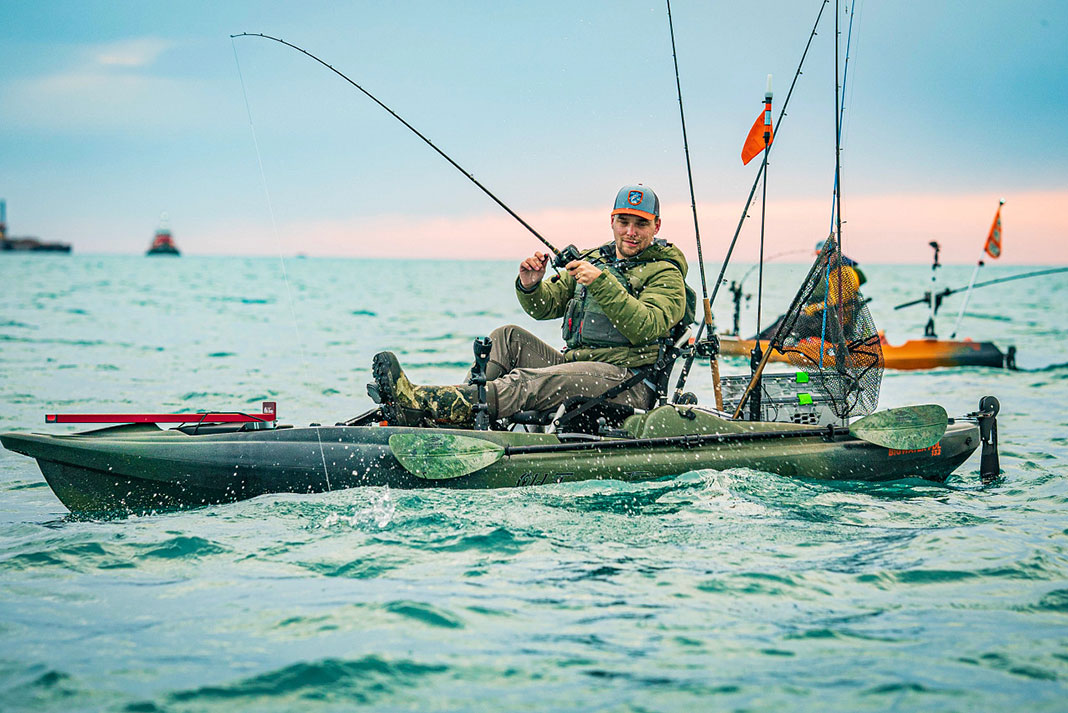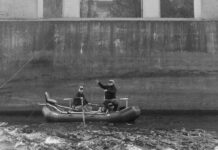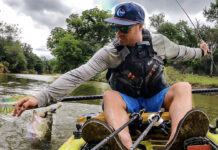It’s the ultimate kayak destination. The biggest water with the biggest fish and the biggest adventure. Pushing off the beach, paddling through the surf and fishing the open ocean will push an angler’s skills, stamina and luck to the edge. While open ocean angling is the big prize, it is open to anyone. The four anglers we profiled make open water fishing look easy. With their advice, you can fish the big blue, too.
4 Big Water Anglers Share Their Ocean Fishing Tactics

1 Brian Nellie | Southeastern Florida
Pro guide, three-time Extreme Kayak Fishing Tournament winner
Target Species: Sailfish, kingfish, blackfin tuna, mahi mahi, wahoo, snapper, cobia.
A Day on the Water: Along the east coast of Florida, the current moves from south to north. We paddle out one to three miles and slow troll as far as 15 miles.
Electronics: Garmin EchoMAP fish finder, GPS combo. Marking depth and finding structure is essential when fishing off Southeastern Florida. Many times the fish hold in a specific depth. If you catch one sailfish at 20 fathoms, you’ll probably catch more in that same depth. Bottom fishing for snapper requires a GPS with map to find reefs and wrecks that hold the fish.
Rigging: Keep it simple, more stuff on the kayak is more stuff to paddle around and lose in the surf.
Rods, Reels, Line and Leader: Shimano Trevala 6’6”, Shimano Spheros 10,000 spinning reel, 30-to 40-pound braid with 40- to 60-pound Yo-Zuri fluorocarbon leader.
Rigs and Lures: For live bait a standard stinger rig of two to three feet of 60-pound wire leader and 3/0 live bait hook in the front and 4x 4/0 treble as the stinger. Four- to six-ounce speed jigs for tuna, kings and snapper.
Surf Launch Secrets: Watch the sets of waves for a break then go like hell.
Livewell: 10-gallon Brute trashcan with two battery-powered aerators.
Rod Holders: Hobie extended tubes keep the reel out of the water while using the existing flush mount rod holders.
Safety First: Life jacket, pealess whistle, VHF, and cellphone.

2 Ty Southerland | Pensacola, Florida
Captain, pro guide and host of 30milesOut
Target Species: Red drum, speckled trout, king mackerel, mahi mahi, sailfish, tarpon and cobia.
A Day on the Water: Hit the beach at dawn. As soon as I cross the surf zone I catch hardtail jacks and cigar minnows. Slow troll live baits along the beach while keeping a lookout for schools of albacore, bonita and Spanish mackerel. Fish until noon, when the sun gets too hot.
Electronics: No electronics, we blind troll and look for working fish.
Rigging: Use a cart with balloon tires to carry a fully-rigged kayak across the beach.
Rods, Reels, Line and Leader: Seven-foot, medium-heavy rods and 5,000 series spinning reels spooled with 30- to 50-pound braided line and a 30-pound shock leader. Use a blood knot to barrel knot to connect braid to mono.
Rigs and Lures: Got-Cha plugs for casting to bait schools. Live bait, use a stinger rig with one-foot leader of 43-pound single strand wire. If the fish are finicky, we’ll move down to 27-pound wire and make the leader two and a half feet long.
Surf Launch Secrets: Get off the water before afternoon sea breezes kick up.
Livewell: I keep live baits in the MirageDrive well. Stick them in head down so the water crosses their gills.
Rod Holders: Keep the trolling rod in molded-in rod holder behind the seat. Casting rod goes in front rod holder.
Safety First: Safety in numbers. The more anglers on the water, the more eyes on the sky and ocean conditions. Keep an eye on each other and maintain a head count. A lost paddle or disabled pedal drive and you’ll be eating plantains in Cuba. I always carry a safety knife on my PFD so if I become tangled in the line, I can cut myself free.

3 Jeff Herman | Gulf of Mexico, Texas
Tournament angler and Kayak Angler contributor
Target Species: Red drum, crevalle jacks, Spanish mackerel and sharks.
A Day on the Water: Launch at High Island, Texas. Troll and chase shrimp boats. Or anchor just past the breakers and fish live baits. I call it “gentleman fishing” because the surf launch is easy and I can paddle into shore to take a break.
Electronics: I don’t need a large screen or GPS, so I use a small, color fish finder to identify fish, bait and structure.
Rigging: I carry gear and tackle in a milk crate that is bungeed and Zip-tied to the kayak so it doesn’t come off in case of a spill. I use rod holders that I can turn parallel to the kayak so the rods don’t snap if I go over.
Rods, Reels, Line and Leader: Seven-foot, heavy-duty conventional rod matched with a reel with 30 pounds of drag to turn the head of a big shark. Thirty-pound line and 100-pound leader.
Rigs and Lures: A 10/0 circle hook. For sharks, I go with 60-pound steel leader. For bull drum, I use 50-pound monofilament leader.
Gadgets, Gizmos and Gaffs: Most important accessory is a great paddle. A lightweight, powerful paddle makes it easier to cover miles and speed through the surf.
Safety First: Learn to properly use a VHF radio. Follow radio protocol when calling for help. Always call for a radio check before leaving the beach.

4 Nick Wakida | Maui, Hawaii
Third place Makena Landing Kayak Fishing Tournament, sixth place Aquahunters Makahiki Kayak Fishing Tournament, landed 187.6-pound yellowfin tuna, largest in a kayak
Target Species: Tunas, mahi mahi, billfish.
A Day on the Water: Hit the water before sunrise to catch bait. Trolling, drifting and jigging for five to eight hours.
Electronics: A fish finder with accurate water temperature readout will help identify breaks and eddies that could hold bait and fish.
Rigging: I use outriggers with inflatable pontoons to improve stability on open water.
Rods, Reels, Line and Leader: Two six-foot trolling rods with 5/0 lever drag reels with 50-pound monofilament and 65-pound wire leader. Two medium-action spinning rods spooled with 50-pound braid and a 15-foot, 30-pound topshot of fluorocarbon. To catch bait, I’ll use 15-pound fluorocarbon on a Sabiki rig.
Rigs and Lures: I use a stinger rig with 5/0 live bait hook and 45 to 80 pound leader. For live bait, I use a Nitta R3 ring bridle that keeps the bait swimming upright. Hook a dead opelu through the lips.
Livewell: Take a four-inch PVC pipe and cut it to two-and-a-half feet. Close the ends with threaded plugs. Drill holes throughout the pipe. Tie a rope to one end and pull behind the kayak.
Rod Holders: I added PVC extensions to my rod holders to raise the rods and give me more options for placing the rod holders.
Gadgets, Gizmos and Gaffs: I carry a gaff with a four-inch bite and a three-foot handle. I mostly use my kage gaff with a barbless spike.
Wahoo! Toothy Speed demons with a delicate white meat. | Feature photo: Brian Nellie










